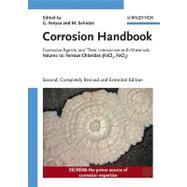
Corrosion Handbook Vol. 12 : Corrosive Agents and Their Interaction with Materials Ferrous Chlorides (FeCl2, FeCl3)
by Kreysa, Gerhard; Sch?tze, MichaelRent Textbook
New Textbook
We're Sorry
Sold Out
Used Textbook
We're Sorry
Sold Out
eTextbook
We're Sorry
Not Available
Summary
Author Biography
Michael Schütze, born 1952, studied materials sciences at the University of Erlangen-Nürnberg from 1972 to 1978, then joined the Karl Winnacker Institute of the DECHEMA as a research associate. He received his doctorate in engineering sciences from the RWTH (Technical University) in Aachen in 1983, completed his habilitation in 1991, becoming a member of the external teaching staff of the RWTH. Since 1998, he holds a professorship there. In 1996, he was appointed director of the Karl Winnacker Institute. He is recipient of the Friedrich-Wilhelm-Prize and the Rahmel-Schwenk medal, past Chairman of the Gordon Research Conference on Corrosion, editor of the journal Materials and Corrosion and Chairman of the European Federation Working Party Corrosion by Hot Gases and Combustion Products.
Table of Contents
| List of Contributors | p. VII |
| Preface | p. IX |
| How to use the Corrosion Handbook | p. XI |
| Ferrous/Ferric Chloride (FeCl2, FeCl3) | p. 1 |
| Authors: A. Werner/Editor: R. Bender | |
| Metallic materials | p. 30 |
| Aluminium and aluminium alloys, copper and copper alloys, iron, iron-based alloys and steels, nickel and nickel alloys, titanium and titanium alloys, zinc, cadmium and their alloys | |
| Non-metallic inorganic materials | p. 359 |
| Carbon and graphite, binders for building materials, glass, quartz ware and quartz glass, enamel, oxide ceramic materials, metal ceramic materials | |
| Organic materials/plastics | p. 364 |
| Thermoplastics, thermosetting plastics, elastomers, duroplasts | |
| Materials with special properties | p. 370 |
| Coatings and linings, seals and packings, composite materials | |
| Bibliography | p. 376 |
| Key to materials compositions | p. 395 |
| Material index | p. 433 |
| Subject index | p. 440 |
| Table of Contents provided by Ingram. All Rights Reserved. |
An electronic version of this book is available through VitalSource.
This book is viewable on PC, Mac, iPhone, iPad, iPod Touch, and most smartphones.
By purchasing, you will be able to view this book online, as well as download it, for the chosen number of days.
Digital License
You are licensing a digital product for a set duration. Durations are set forth in the product description, with "Lifetime" typically meaning five (5) years of online access and permanent download to a supported device. All licenses are non-transferable.
More details can be found here.
A downloadable version of this book is available through the eCampus Reader or compatible Adobe readers.
Applications are available on iOS, Android, PC, Mac, and Windows Mobile platforms.
Please view the compatibility matrix prior to purchase.
